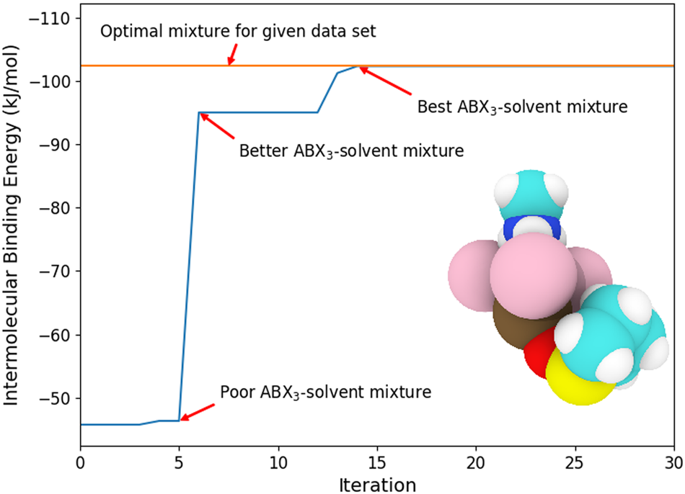npj Computational Materials ( IF 9.7 ) Pub Date : 2018-09-10 , DOI: 10.1038/s41524-018-0106-7 Henry C. Herbol , Weici Hu , Peter Frazier , Paulette Clancy , Matthias Poloczek

|
Accelerated searches, made possible by machine learning techniques, are of growing interest in materials discovery. A suitable case involves the solution processing of components that ultimately form thin films of solar cell materials known as hybrid organic–inorganic perovskites (HOIPs). The number of molecular species that combine in solution to form these films constitutes an overwhelmingly large “compositional” space (at times, exceeding 500,000 possible combinations). Selecting a HOIP with desirable characteristics involves choosing different cations, halides, and solvent blends from a diverse palette of options. An unguided search by experimental investigations or molecular simulations is prohibitively expensive. In this work, we propose a Bayesian optimization method that uses an application-specific kernel to overcome challenges where data is scarce, and in which the search space is given by binary variables indicating whether a constituent is present or not. We demonstrate that the proposed approach identifies HOIPs with the targeted maximum intermolecular binding energy between HOIP salt and solvent at considerably lower cost than previous state-of-the-art Bayesian optimization methodology and at a fraction of the time (less than 10%) needed to complete an exhaustive search. We find an optimal composition within 15 ± 10 iterations in a HOIP compositional space containing 72 combinations, and within 31 ± 9 iterations when considering mixed halides (240 combinations). Exhaustive quantum mechanical simulations of all possible combinations were used to validate the optimal prediction from a Bayesian optimization approach. This paper demonstrates the potential of the Bayesian optimization methodology reported here for new materials discovery.
中文翻译:

通过贝叶斯优化有效搜索有机-无机钙钛矿杂化体的成分空间
通过机器学习技术实现的加速搜索对材料发现越来越感兴趣。一种合适的情况是对组件进行固溶处理,最终形成称为混合有机-无机钙钛矿(HOIPs)的太阳能电池材料薄膜。在溶液中结合形成这些膜的分子种类的数量构成了巨大的“组成”空间(有时超过500,000种可能的结合)。选择具有理想特性的HOIP涉及从多种选择中选择不同的阳离子,卤化物和溶剂混合物。通过实验研究或分子模拟进行的无向导搜索代价高得令人望而却步。在这项工作中,我们提出了一种贝叶斯优化方法,该方法使用特定于应用程序的内核来克服数据稀缺的挑战,其中的搜索空间由表示变量是否存在的二进制变量给定。我们证明了所提出的方法能够以比以前的最新贝叶斯优化方法低得多的成本,并且在所需时间的一小部分(少于10%)中识别出具有目标最大的HOIP盐和溶剂之间的分子间结合能的HOIP。完成详尽的搜索。在包含72种组合的HOIP组成空间中,我们在15±10次迭代中找到了最佳组合,而在考虑混合卤化物(240种组合)时,我们在31±9次迭代中找到了最佳组合。所有可能组合的详尽的量子力学模拟被用来验证贝叶斯优化方法的最优预测。本文证明了此处报道的贝叶斯优化方法在发现新材料方面的潜力。


























 京公网安备 11010802027423号
京公网安备 11010802027423号